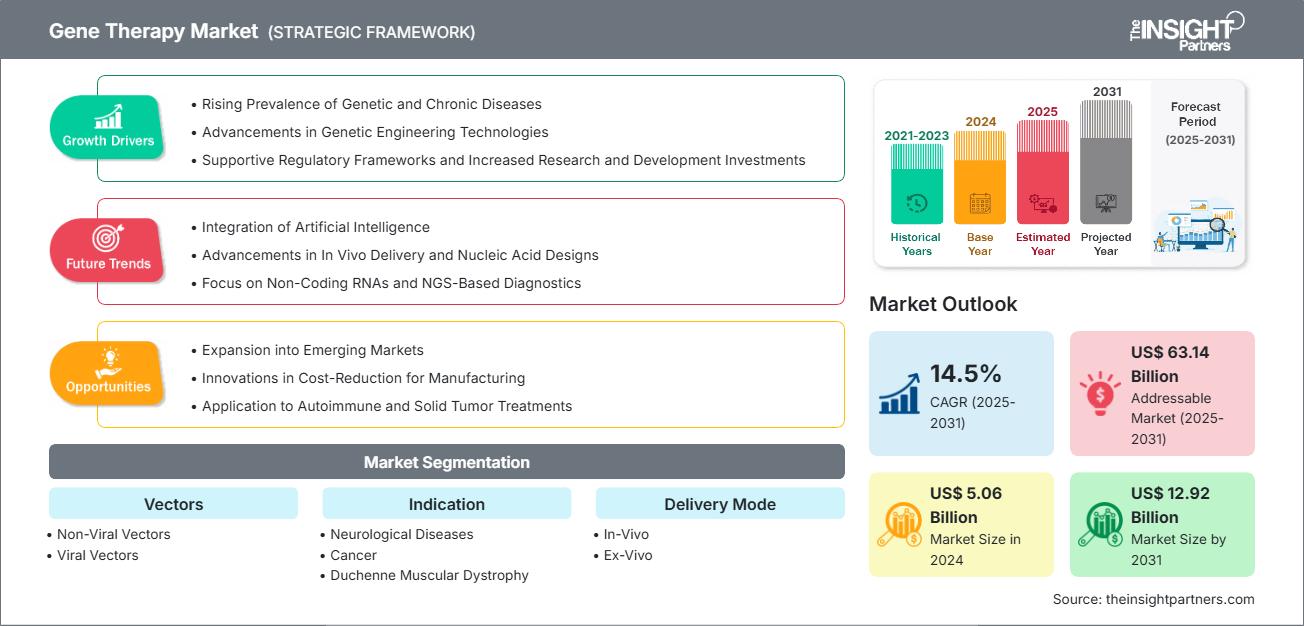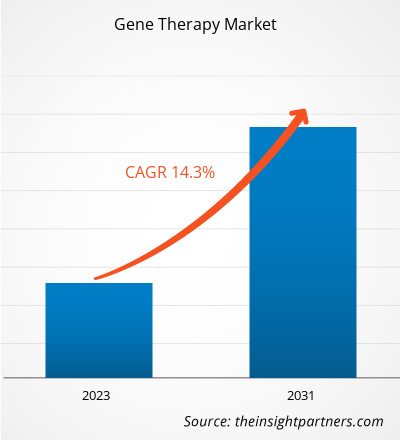基因治疗市场规模预计将从 2024 年的 50.6 亿美元增至 2031 年的 129.2 亿美元。预计 2025 年至 2031 年期间该市场的复合年增长率将达到 14.50%。
基因治疗市场分析
慢性病和遗传病患病率的上升、基因工程技术的不断进步、支持性监管框架的完善以及研发投入的增加,都有利于基因治疗市场的增长。将人工智能 (AI) 融入个性化医疗,有助于市场发展。新兴经济体的疾病流行率和医疗基础设施不断改善,蕴藏着巨大的机遇。
基因治疗市场概况
基因治疗是一种医学方法,通过灭活缺陷基因、用健康基因替换、或将新的或修饰的基因引入体内来帮助治疗或预防疾病。基因治疗可分为体内基因治疗和体外基因治疗。基因治疗用于治疗癌症、神经系统疾病、心血管疾病、传染病和罕见疾病。基因治疗包括操纵基因来对抗或预防疾病。该疗法通过将功能性基因引入患有由缺陷或突变基因引起的疾病的个体体内来发挥作用。治疗方法包括生物仿制药、疫苗、复杂仿制药、基因疗法、免疫疗法和新型药物。
您将获得任何报告的免费定制,包括本报告的部分内容、国家级分析、Excel 数据包,以及为初创企业和大学提供优惠和折扣
基因治疗市场:战略洞察

-
获取此报告的顶级关键市场趋势。此免费样品将包括数据分析,从市场趋势到估计和预测。
基因治疗市场驱动因素和机遇
市场驱动因素:
- 遗传疾病和癌症的患病率不断上升:在美国,约有 2500 万至 3000 万人患有罕见疾病,其中许多是遗传性疾病,适合基因治疗。
- 基因工程技术的进步:基因工程技术的最新创新,例如 CRISPR/Cas9、碱基编辑和增强型病毒载体,加速了治疗方法的开发和应用。
- 政府支持举措:从 2024 年到 2025 年,FDA 加快了细胞和基因疗法的审批流程,重点关注创新和持续监测。
- 扩大医疗保健基础设施:研发投资激增,由于公私合作伙伴关系和拨款,全球资金已达数十亿美元,这使得全球范围内开展了 3,000 多项临床试验。
- 基因治疗 CDMO 的扩张:细胞和基因治疗行业著名的 CDMO RoslinCT 和 Lykan Bioscience 已组建一家以 RoslinCT 品牌运营的统一公司。
市场机会:
- 拓展新兴市场:CRISPR 和基因递送系统等先进基因编辑技术的采用,使治疗更加有效、精准。随着这些创新技术的普及,它们为基因疗法铺平了道路,以满足尚未满足的医疗需求,使治疗方案更加智能、可靠且更具成本效益。
- 个性化医疗:开发可根据不同基因特征定制的治疗方案,助力精准医疗。医疗保健专业人员可以根据每位患者的个性化需求,优化治疗方案,减少浪费,并简化治疗方案的升级。
- 市场参与者的研发活动:投资利用非病毒传递方法、提高安全性和改善患者治疗效果的基因治疗技术研究可提供竞争优势。
- 自身免疫和实体瘤治疗等新兴应用:肿瘤学、罕见遗传疾病和慢性疾病等领域对创新治疗的需求不断增长,推动了基因治疗市场的增长。
基因治疗市场报告细分分析
我们将基因治疗市场划分为不同的细分市场,以便更清晰地了解其运作方式、增长潜力以及最新的基因治疗市场趋势。以下是行业报告中使用的标准细分方法:
按向量:
- 非病毒载体:对非病毒载体的日益偏好正在通过拓宽其治疗潜力来影响基因治疗市场的动态。
- 病毒载体:源自腺相关病毒 (AAV)、慢病毒、腺病毒和逆转录病毒的病毒载体构成了 FDA 批准的基因疗法的支柱。
按适应症:
- 神经系统疾病:基因疗法的发展提供了潜在的一次性治愈方法,而不是对神经退行性疾病和脊髓性肌萎缩症 (SMA) 等疾病进行终生症状管理。
- 癌症:癌症发病率的上升增加了对基因疗法等先进的靶向治疗的需求。
- 杜氏肌营养不良症:随着杜氏肌营养不良症病例数量的增加,对基因疗法等治疗方案的需求也越来越迫切,因为这些方案需要解决根本原因,包括肌营养不良蛋白基因突变,而不仅仅是缓解症状。
- 肝病:肝病病例的增加刺激了制药行业的投资,各公司纷纷加快临床试验和监管提交,以抢占不断扩大的市场。
- 其他适应症:罕见疾病发病率的增加推动了基因治疗技术(如抗体-药物偶联物)的使用。
按交付方式:
- 体内
- 离体
按地理位置:
- 北美
- 欧洲
- 亚太地区
- 拉美
- 中东和非洲
基因治疗市场区域洞察
Insight Partners 的分析师已详尽阐述了预测期内影响基因治疗市场的区域趋势和因素。本节还讨论了北美、欧洲、亚太地区、中东和非洲以及南美和中美洲的基因治疗市场细分和地域分布。
基因治疗市场报告范围
| 报告属性 | 细节 |
|---|---|
| 2024年的市场规模 | 50.6亿美元 |
| 2031年的市场规模 | 129.2亿美元 |
| 全球复合年增长率(2025-2031) | 14.5% |
| 史料 | 2021-2023 |
| 预测期 | 2025-2031 |
| 涵盖的领域 |
通过矢量
|
| 覆盖地区和国家 |
北美
|
| 市场领导者和主要公司简介 |
|
基因治疗市场参与者密度:了解其对商业动态的影响
基因治疗市场正在快速增长,这得益于终端用户需求的不断增长,而这些需求的驱动因素包括消费者偏好的演变、技术进步以及对产品益处的认知度的提升。随着需求的增长,企业正在扩展产品线,不断创新以满足消费者需求,并抓住新兴趋势,从而进一步推动市场增长。

- 获取基因治疗市场主要参与者概览
基因治疗市场份额地域分析
亚太地区的基因治疗市场正经历着最快的增长。更快的订单履行需求、蓬勃发展的电商生态系统以及对蓬勃发展的电商生态系统的投资是推动市场扩张的因素。拉丁美洲、中东和非洲的新兴市场为基因治疗提供商提供了尚未开发的扩张机会。各地区的基因治疗市场增长情况各不相同。以下是各地区市场份额和趋势的摘要:
1. 北美
- 市场份额:占据全球市场的很大份额
- 关键驱动因素:创新研发的不断增加推动了该地区基因治疗市场规模的不断增长。美国食品药品监督管理局 (FDA) 已批准 7 种细胞和基因治疗药物,新产品研发管线已达约 1,200 种实验性疗法。其中一半处于二期临床试验阶段。根据《化学与工程新闻》2023 年报告的估计,细胞疗法的年销售额增长率约为 15%,基因疗法的年销售额增长率约为 30%。
- 趋势:市场参与者在基因编辑中采用人工智能。
2.欧洲
- 市场份额:由于早期采用 CRISPR/Cas9、碱基编辑和改进的病毒载体技术,占据了相当大的份额。
- 关键驱动因素:先进研究设施的可用性以及对用于基因疗法研究和开发的技术先进的基因工程工具的高需求促进了该地区市场的增长。
- 趋势:对智能基因编辑解决方案的投资。
3. 亚太地区
- 市场份额:该地区增长最快,市场份额每年都在增加。
- 关键驱动因素:强大且支持性的研究基础设施和政府法规推动了基因疗法的推广应用。该地区各国正面临日益加重的慢性病和遗传疾病负担,从而增加了对创新疗法的需求。该地区市场参与者不断增长的业务扩张战略正在推动基因治疗市场份额的增长。
- 趋势:增加对基因治疗的投资以及与亚太地区 CDMO 的合作。
4. 南美洲和中美洲
- 市场份额:市场稳步增长
-
关键驱动因素:
- 该地区遗传性疾病和罕见疾病的日益流行,对先进疗法的需求日益迫切。此外,政府大力发展医疗基础设施的举措也推动了先进疗法的采用。巴西卫生部下属的研究基金会Fiocruz于2024年3月与Caring Cross合作,在巴西建立CAR-T疗法的本地生产基地。此次合作预计将使巴西每剂CAR-T疗法的成本降至3.5万美元。
- 趋势:扩大临床试验支持基因疗法的发展。
5.中东和非洲
- 市场份额:虽然较小,但增长迅速
-
关键驱动因素:
- 在阿联酋基因组计划等政府举措下,不断增加的基础设施投资对于增加基因疗法的需求至关重要。
- 支持创新研究和开发的强有力的监管审批框架推动了基因治疗市场的增长。
- 趋势:公私合作采用新的基因编辑技术。
基因治疗市场参与者密度:了解其对商业动态的影响
市场密度高,竞争激烈
由于BEUMER Group GmbH & Co KG和Bastian Solutions LLC等老牌企业的存在,竞争十分激烈。Orchard Therapeutics(欧洲)、Passage Bio(美国)和Yapan Bio(印度)等区域性和利基供应商也加剧了跨地区的竞争格局。
这种激烈的竞争促使公司通过提供以下产品脱颖而出:
- 高级安全功能
- 增值服务,例如分析和预测性维护、实时运营分析和安装
- 有竞争力的定价模式
- 强大的客户支持和轻松的集成
机遇与战略举措
- 制造商和 CDMO 合作利用先进的基因工程工具开发新的基因疗法。
- 美国 FDA、加拿大卫生部和 ANVISA 等监管机构简化了审批流程,以便快速轻松地推出创新产品。
- 学术机构和研究机构正在利用政府补助和资金扩大研究能力。
研究过程中分析的其他公司:
- Intellia治疗公司
- 萨那生物技术
- 驯鹿生物科学公司
- 埃迪塔斯医学
- Beam治疗公司
- 桑加莫治疗公司
- 自由线
- Orchard Therapeutics
- uniQure
- 辉瑞
- Takara生物公司
- PTC治疗公司
- Adaptimmune Therapeutics
- Adverum生物技术公司
- 拜耳
- eGenesis
基因治疗市场新闻和最新发展
-
AGC Biologics 成立了专门的细胞和基因业务部门。AGC Biologics 成立的全新细胞和基因技术部门将专注于提升 AGC Biologics 的现有能力,并为需要产能、科研能力以及技术合格的细胞和基因 CDMO 运营商的开发商提供支持。该部门拥有 30 年的细胞和基因治疗经验,已获得 9 项商业批准,并成功生产了数百个符合 GMP 标准的批次。
- FDA 批准 Casgevy 和 Lyfgenia 用于治疗镰状细胞病患者 Casgevy 是 FDA 批准的首个利用 CRISPR/Cas9 基因组编辑技术的疗法。患者造血干细胞通过 CRISPR/Cas9 技术进行基因组编辑。
基因治疗市场报告覆盖范围和交付成果
《基因治疗市场规模和预测(2021-2031)》报告对以下领域进行了详细的市场分析:
- 基因治疗市场规模及全球、区域和国家层面所有关键细分市场的预测
- 基因治疗市场趋势以及市场动态,例如驱动因素、限制因素和关键机遇
- 详细的 PEST 和 SWOT 分析
- 基因治疗市场分析涵盖主要市场趋势、全球和区域框架、主要参与者、法规和最新市场发展
- 行业格局和竞争分析,涵盖市场集中度、热图分析、知名参与者以及基因治疗市场的最新发展
- 详细的公司简介
- 历史分析(2 年)、基准年、预测(7 年)及复合年增长率
- PEST和SWOT分析
- 市场规模、价值/数量 - 全球、区域、国家
- 行业和竞争格局
- Excel 数据集
近期报告
客户评价
购买理由
- 明智的决策
- 了解市场动态
- 竞争分析
- 客户洞察
- 市场预测
- 风险规避
- 战略规划
- 投资论证
- 识别新兴市场
- 优化营销策略
- 提升运营效率
- 顺应监管趋势






















 获取免费样品 - 基因治疗市场
获取免费样品 - 基因治疗市场